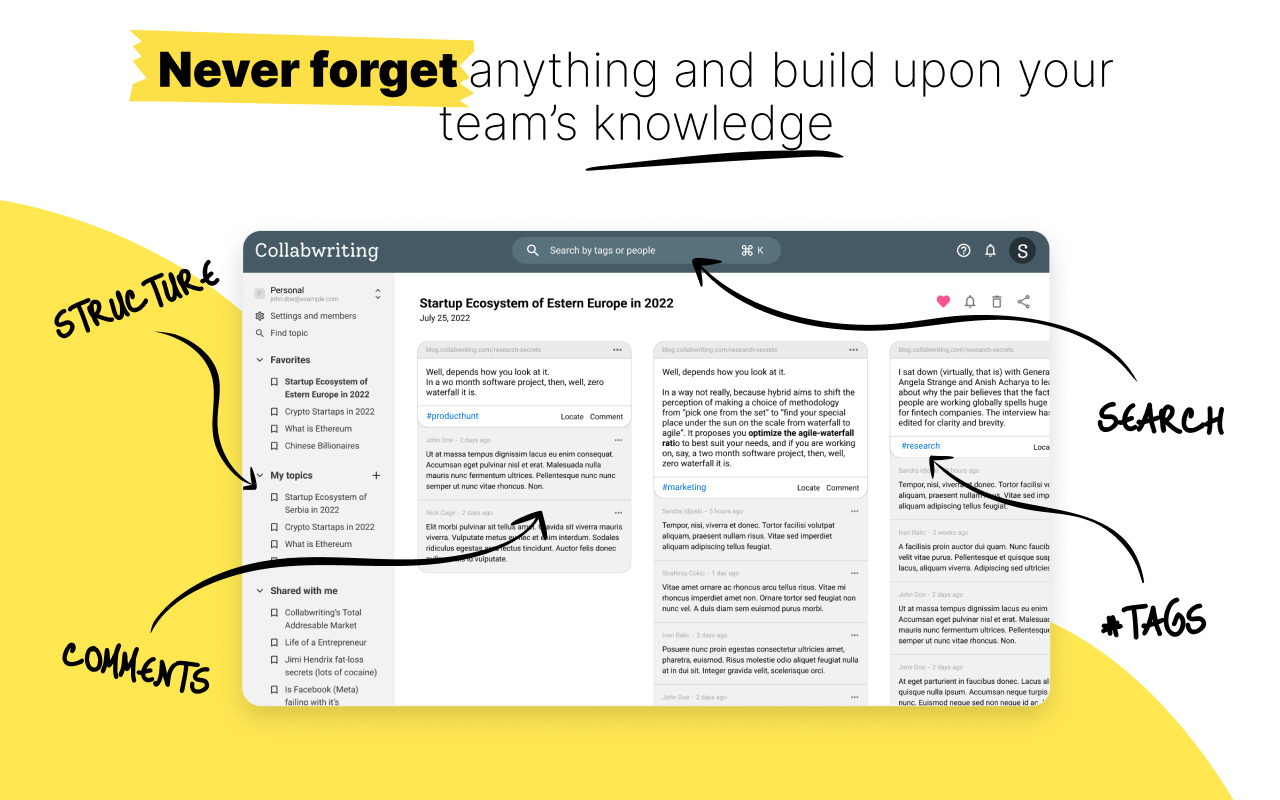Nothing kills productivity faster than having to "hunt down" the right file everywhere. Searching through folders, using different tools, or bothering colleagues not only hampers efficiency but also doesn't contribute to good teamwork and collaboration.
In fact, a Panopto study reveals that 81% of respondents are frustrated when they can't access the information they need to get their job done.
Whether you're working remotely or not, all team members can only benefit when collaboration is seamless and access to information is readily available. This is why it's time to end the unproductive back-and-forth communication that drains energy.
To achieve this, you'll need a system that supports your business both today and in the future.
That involves utilizing internal knowledge base software to build a knowledge hub.
In this step-by-step guide, you will learn how to create an internal knowledge base that meets your organization's needs.
Types of knowledge base systems
There are 5 primary categories of knowledge bases, which are as follows:
- Internal knowledge base
- Hosted knowledge base
- Self-hosted knowledge base
- Customer service knowledge base
- Open-source knowledge base software
What is an internal knowledge base?
Internal knowledge bases act as a central hub for storing, managing, and sharing employee knowledge. The purpose of this information repository is to improve productivity by allowing employees to easily access the information required for specific tasks, thereby improving job performance.
Unlike customer-service knowledge bases, which are open to everyone, internal knowledge bases are designed for use by members within the organization.
By centralizing knowledge, you can eliminate redundancies, decrease reliance on tribal knowledge, and foster better collaboration among team members.
Whether it's onboarding new employees, resolving common issues, or ensuring consistent communication across departments, an internal knowledge base promotes efficiency and empowers your workforce.
The importance of an internal knowledge base
A well-organized and comprehensive internal knowledge base is crucial for any organization.
By centralizing knowledge, you can eliminate redundancies, decrease reliance on tribal knowledge, and foster better collaboration among team members.
Whether it's onboarding new employees, resolving common issues, or ensuring consistent communication across departments, an internal knowledge base promotes efficiency and empowers your workforce.
What to put in your internal knowledge base?
Company information: Annual reports, organizational charts, and contact lists.
Training material: Onboarding materials, employee training plans and templates, health and safety training, and certification training.
Best Practices: Including best practices in your internal knowledge base is essential for promoting efficiency and productivity within your organization. These best practices can cover a wide range of topics, such as project management, communication, customer service, and more. By sharing proven strategies and techniques, employees can learn from each other's experiences and adopt successful approaches to their work.
Sales collateral: Case studies, sell sheets, sales process information, and the latest sales numbers.
HR material: Employee handbooks, payslips, and employee review forms.
Documentation: Process documentation, software documentation, standard operating procedures, and checklists.
Marketing collateral: Editorial calendars, social media post templates, and copywriting guidelines.
Media and press kit: Press releases, contact lists, and press images.
Design files: Design guidelines, branding handbook, and color codes.
Legal documents: Contracts, release forms, policies, and regulatory documents.
Customer service: FAQs, call scripts, and email templates that can help your customer support team better assist customers
The benefits of using internal knowledge base software
An effective internal knowledge base offers a lot of benefits. They include:
Improve employee productivity
Productivity takes a nosedive when you're stuck waiting for the right information.
According to a Panopto study, the average employee loses 5.3 hours each week just trying to find what they need.

It fosters collaboration among team members
Employees from different departments can contribute to the knowledge base by offering a centralized platform for sharing knowledge. This fosters cross-functional collaboration and allows teams to learn from each other's experiences, ultimately leading to more innovative and efficient solutions.
With the collaborative features of an internal knowledge base, it’s easier to share knowledge as team members can work together in real-time, get comments, and request improvements from colleagues.
Improves onboarding and training
When it comes to onboarding new employees, having an internal knowledge base can significantly streamline the process. Instead of dragging through endless training sessions, new hires can access the knowledge base to pick up the lowdown on company rules, procedures, and useful tips.
This not only saves time but also ensures that all employees receive consistent and accurate information.
It's not just onboarding that gets a boost when you gather all the necessary info in one spot, but regular company training benefits too.
Prevent knowledge loss
Does your organization have a way of retaining tacit knowledge? If not, every time someone leaves, you're at risk and end up spending time, energy, and resources to fill the knowledge gap.
On average, large U.S. companies lose about $42.5 million yearly because they're not sharing knowledge effectively, and a significant portion of that is due to knowledge loss.
By improving how your organization shares and transforms tacit knowledge into explicit knowledge, you can cut down on the costs of recovering lost information.
Improve work flexibility
Traditional methods often lock information in content silos like hard drives.
By storing knowledge in a central, cloud-based hub, you and your team can access it from anywhere. This accessibility minimizes the disruption of unexpected sick days, canceled flights, or bad weather.
Troubleshooting common issues
Instead of relying on a few individuals with specific expertise, employees can search through the knowledge base to find solutions to common issues.
This not only eases the workload on a few individuals but also encourages a culture where everyone can handle things independently and take the initiative to solve problems within the organization.
What makes a great knowledge base?
Up-to-date info: Regular updates keep the information accurate and relevant. Automated updates and input from subject matter experts ensure it stays on point.
User-friendly dashboard: Designed with the end-user in mind, it's super easy to use. Finding the info you need is quick and painless.
Search power: A robust search function lets users swiftly locate information. It provides spot-on results based on what the user is looking for.
Access management: It should provide flexible access management features. This way, you can choose who you share that knowledge with and determine who has editing capabilities.
Collaboration tools: Encourages teamwork and knowledge sharing. Features like commenting let users contribute, keeping things current, and fostering a culture of collaboration and learning.

Collabwriting - Shareable Notes on Web Pages and PDFs
Share and grow knowledge together. Simply highlight, save, and collaborate with anyone on any content you find online.
Conclusion
Having an internal knowledge base is like giving your organization a turbo boost in efficiency and effectiveness. It brings all the info to one spot, gets people working together, and keeps everyone on the same page.
Getting an internal knowledge base is not just spending; it's an investment in making your team and organization grow and succeed.





![Best Research Collaboration Tools in 2025: Zotero, Paperpile & Collabwriting [Compared]](/content/images/2025/07/image--7--1.png)







